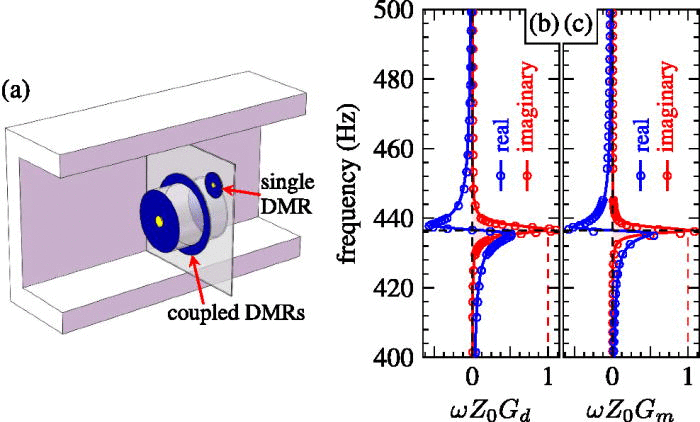September 16, 2015 report
Researchers achieve near-perfect absorption of sounds waves

(Phys.org)—A team of researchers at Hong Kong University of Science and Technology has found a way to create a material that is near perfect at preventing sound waves from passing through it. In their paper published in Applied Physics Letters, the team describes the theory behind their idea, the technique they used, two products they produced and how close to near perfection they came.
Technically, the material created by the team does not absorb sound, instead it scatters sound waves and then dissipates them, resulting in sound wave reduction of 99.7 percent. To achieve this feat, the team used two decorated membrane resonators (DMRs) built together, both of which were tuned to the same frequency. The impedance of both was set to match the environment, which was normal air.
Typically, materials used to prevent noise from passing from one environment to another combine several ingredients, each of which is designed to absorb a certain frequency—the problem with this approach is that it does not stop all frequencies, because that would require too many ingredients (causing the thickness of the finished product to grow beyond usefulness). Using resonators allowed the researchers to get around this limitation—those used were made to vibrate naturally based on the object to which they were affixed. The first resonator caused sound waves to be canceled out, but because it also scattered some of its own frequencies, a second resonator was added to scatter those from the first. The result was a single layer material that offers near perfect absorption of sound waves, notably, including those at very low frequencies.
The team assembled two sound muting materials based on their concept, both of which used DMRs. The first consisted of a flat panel along with dual coupled DMRs—the second one was based on a ventilated short tube that contained a DMR and a DMR backed cavity sidewall. Both achieved near perfect absorption, proving their theory correct.
Presumably, materials created using the new technique could be used in situations that require restriction of a wide range of frequencies, such as recording studios, audio laboratories or even perhaps in headphones, speakers or earbuds.
More information: Subwavelength total acoustic absorption with degenerate resonators, Appl. Phys. Lett. 107, 104104 (2015); dx.doi.org/10.1063/1.4930944
ABSTRACT
We report the experimental realization of perfect sound absorption by sub-wavelength monopole and dipole resonators that exhibit degenerate resonant frequencies. This is achieved through the destructive interference of two resonators' transmission responses, while the matching of their averaged impedances to that of air implies no backscattering, thereby leading to total absorption. Two examples, both using decorated membrane resonators (DMRs) as the basic units, are presented. The first is a flat panel comprising a DMR and a pair of coupled DMRs, while the second one is a ventilated short tube containing a DMR in conjunction with a sidewall DMR backed by a cavity. In both examples, near perfect absorption, up to 99.7%, has been observed with the airborne wavelength up to 1.2 m, which is at least an order of magnitude larger than the composite absorber. Excellent agreement between theory and experiment is obtained.
Journal information: Applied Physics Letters
© 2015 Phys.org




















